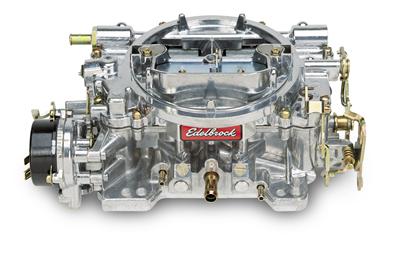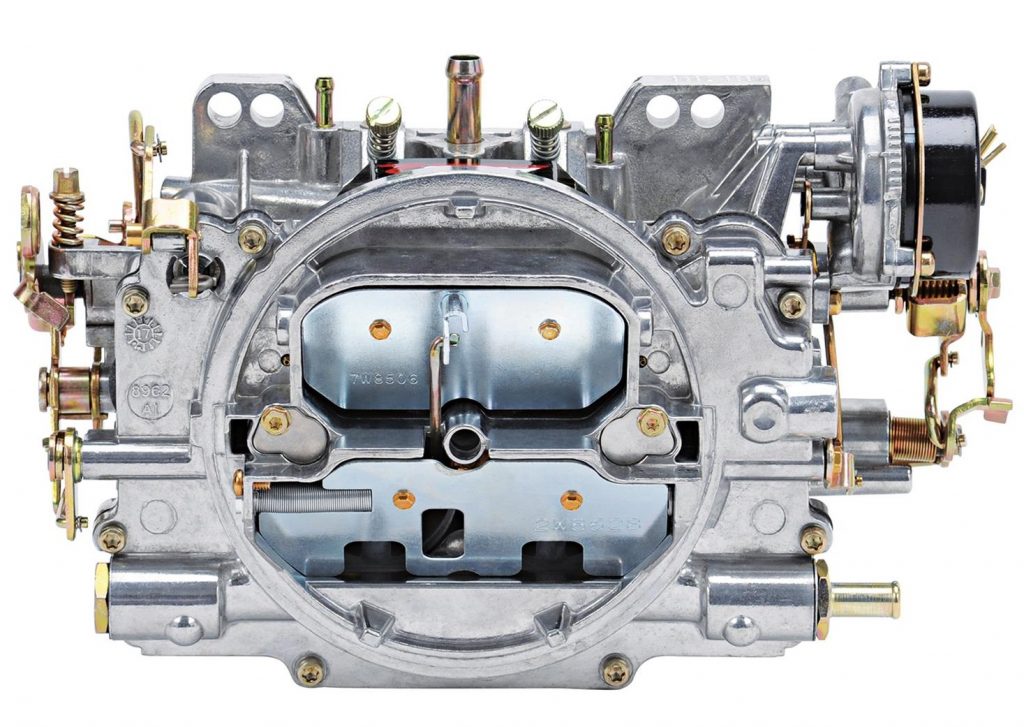It’s the Edelbrock 1406 Performer carburetor versus the Edelbrock 1906 AVS carburetor.
We’re not pitting these two carbs against each other because they’re mortal enemies (they’re from the same family, for goodness sake), but because they are two very good and very popular options among classic auto owners.
But which is right for your ride? And how do they stack up head-to-head?
Let’s find out:
Edelbrock 1406

Along with some of the Holley offerings, the Edelbrock 1406 is the quintessential 4-barrel carburetor for street performance.
The 600 cfm 1406 is designed to handle the rigors of day-to-day driving while delivering consistent, reliable street performance. They’re hand-built and precisely tuned — and they’re designed to hold that tune. The venturi booster uses a bottom-feed design for smoother acceleration and better drivability. The overall calibration of the carb will stay consistent and unchanged, so you can always expect optimum performance on the street.
Let’s look at some of the important features, starting with the metering rods. Edelbrock utilizes these metering rods to transition between circuits, which means the carburetor is unaffected by engine backfires. There are no power valves to blow out, and the rods can be changed in seconds without removing the carb from the engine or draining the fuel.
Other features of the 1406 include a lightweight, all-aluminum body with a two-piece body that resists warping. It uses simple tub-type bowls and rear-pivot floats, which make the carburetor reliable and user-friendly. It also has an electric choke, mechanical secondaries, and a square bore flange.
It’s also worth noting that the 1406 is extremely reliable and maintenance-free. There are no gaskets below the fuel bowl level for fewer leaks, and no plastic parts or power valves to blow out.
…
Edelbrock 1906
Edelbrock took its years of carburetor research, development, and tuning experience — including what it’s learned from the 1406 — and used it to create the 1906, also known as the AVS2 Series carburetor.

This means the 1906 offers improved calibration that’s designed for optimum street performance in a wide variety of small cubic-inch, as well as some big block engines! This calibration is achieved through annular flow boosters, which deliver improved off-idle and cruising performance. These boosters incorporate eight, equally spaced orifices to improve fuel metering from idle to the main circuit. It also provides better fuel atomization to eliminate flat spots which may occur when transitioning from idle to full throttle.
Other features of this 650 cfm carburetor include an electric choke, mechanical secondaries, adjustable secondary air valves, and dual fuel inlets.
…
1406 vs. 1906 Head to Head
If you’re still having a hard time understanding the differences, here is a head-to-head comparison of features:
| EDL-1406 | EDL-1906 | |
|---|---|---|
| CFM | 600 | 650 |
| Choke | Electric | Electric |
| Booster Type | - | Annular |
| Finish | Silver | Satin |
| Height | 3.250 in. | 3.250 in. |
| Fuel | Gasoline | Gasoline |
| Fuel Inlet | Single | Dual |
| Barrels | 4 | 4 |
| Primary Jet Size | - | 101 |
| Secondary Jet Size | - | 98 |
| Secondary Type | Mechanical | Mechanical |
| Throttle Linkage | Universal | Universal |

I have a 1957 chevy truck that I have put
A 327 with old school 300 horse heads on.
Has small cam just to give it a good sound.
No headers and no alum. Intake. I just
Pleasure drive and take to shows. That has the 1406. Runs out good does super for me.
Starts good when cold. Not sure I could find anything that would work as well or better for me.
1406 you got my vote.
Hi, I have a 1987 Ford E350 chassis motorhome, it has the 460 v8 with c6 tranny. Ive been doing some basic troubleshooting for an extreme loss of power with backfiring under the hood, always on big hills but also seemingly random occurrences during flat city type driving. Oh yeah, I also only get 3mpg!! I started basic with an oil change, replaced plugs & wires and a couple of perforated hoses but was waiting on my air filter to get here to spray the carb with some cleaner. I finally got it, removed the air cleaner & got the surprise of my life! I had been operating on the assumption that I had the Holley 4bbl, but where that should have been was instead a beautiful, (mostly) shiny Edelbrock! Unfortunately though, I’m not sure which one it is. I think it’s either the 1406 or 1906 but I can only look at it from the front where the hoses are attached. Is there any way for me to determine which one it is from that side? I really appreciate your help!!
The carb number is on the lower left front corner of the base plate on the carb.
Can I put an avs2 Annular boosters into a 1406 carb? I’m uninterested in upgrading from the single fuel inlet in the stock 1406 booster venturies.
Hey did you ever find out if the boosters interchange? Certainly be cheaper but i dont see availability on them.
You cant buy just the boosters.
Carburetor reubild kit for Downleg Booster upgrade to New annular Booster compatible with Edelbrock 1406 1405 1409 1400 1403 1404 1805.
Can I put a 1406 on a 1965 Chevy c-15 283 small block V8
What all parts would I need to make it complete
Thank you
Lee
Get a 1 in open spacer plate with gaskets top an botton.l would run an in line gas filter.make sure u replace the carb mounting bolts and remove the factory studs.mount the unite on manifold and hook up gas filter an fuel line.start engine and adjust carb air mix.and should run grate.ok T
Can the same strip kits (jets,metering rods,springs etc.) for the 1405/1406 be used with the 1905/1906 carburetors. Thank you Jr.
Question, can the annular boosters be swapped into my Performer carb?
If so, where would I be able to purchase them?
ThAnks for your time
yea o bought a 1906 today,,bolted it on right out of the box all crap,,eng only ran on 1/2 the eng,,missing,,ran dry on gas 5 times,,never ran good,,i removed a q-jet that had trouble loading up,running real rich,,, i payed $400 for this svs2 carb ,,i bought it at advance in southport nc,,yea they well replace it,,,but will i get the same problem ,,yea it your intake,,its your valve covers,,yae its your 15 in breather,,,real pretty,,but that q=jets back on there,,,its gets me home,,that svs 2 want start the eng ,,real disappointment ,do i need to pull the top off the carb set the floats,,out the box find a needle valve ,,fix this my adress 4678 seapines dr se southport nc 28461,,do you have a good carb laying around,,
Maybe you should learn how to tune a carb. They aren’t always bolt on a go. Chances are actually better that you messed something up anyway.
I have a 1976 Chevy 3/4 ton pickup with a 350 motor and an overhead camper. I want to change out the quadrajet carb to an Edelbrock. How hard is to change from a single fuel intake to a double and which is better for me, the 1406 or the 1906?
Thank you
Intake is pretty much bolt on bolt off, I’d go with the 1406 in that a policy, tried, true, set it and forget it, you can get the entire manifold kit and carb with everything you need from edelbrock fairly reasonable
Had a 1406 switched to a 1906 after a fee issues….initial reaction is its way better but we will see overtime.
Just bought a 1905 , AVS 2 , runs fine till I put a K&N air filter on it , mind you the filter is clean and dried and put new oil on it , then the carb runs rich and cause the motor to backfire and die , I’m at my wits end I know the filter is perfect I tried it on another motor works great , why does this change this carb so much
Your changing the air fuel mixture, you have to set the idle screws appropriately for the filter, different filters flow differently, so what your carb is currently tuned too is now at odds with the air flow it’s now receiving
Based on what I have read, I will go with the 1406 Carb by Edelbrock for a few solid reasons. It has been around a long time and proven. Second, I do only want single fuel feed line. Third, I do not hot rod much, but the one time I do in my 70 Monte with a sac 400, I have that option. I might wait a few years until they take the bugs out of the 1906. Electric choke is a must!
I’m trying to decide between a 1406 and a 1906 for my 1985 Chevy C10. I’ve read a ton of reviews where drivers talk of hard hot starting with a 1406 and it usually sounds like its from heat soak. Does anyone know if the 1906 suffers from the same problem, hot starting due to heat soak?
Edelbrock carbs need a phenolic heat insulator between the manifold and carb to prevent heat soak/fuel evaporation. I think Edelbrock sells them, if not Summit surely does. Get one. Use it. The 1906 AVS design should be superior at preventing bogging upon slamming the pedal.
Thanks for the reply here Barry–and yeah, Summit Racing sells a ton of different phenolic carburetor spacers for a square bore carb like the 1406, click here to check ’em out..
…
More specifically, Edelbrock actually recommends running the carburetor heat insulator gasket, part number EDL-9266.
what about the 1906?
Hey William, thanks for reading, the 1906 is a squarebore flange as well.
Would the 1904 work better than the 1406 on a Ford 302?
Its a bit late for the answer since i just saw it 2 seconds ago but for anyone looking after this .
Yes it does and thats why im digging around here today lol.
Would the 1904 work better than the 1406 on a Ford 302?
I have a 1987 f250 with a 460, I need a new carb, is the 1406 a good choice?